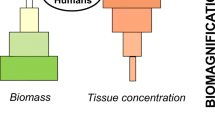Abstract
A series of four papers, commissioned by the European Science Foundation, are presented on the state-of-the-art of the use of biomarkers in environmental assessment. These papers are phylogenetically based and cover invertebrates, vertebrates, plants and invertebrate populations and communities.
Similar content being viewed by others
References
Cairns, J.Jr (1983) Are single species tests alone adequate for estimating environmental hazard?Hydrobiologia 100, 47–57.
Cairns, J.Jr and McCormick, P.V. (1992) Developing an ecosystem-based capability for ecological risk assessments.Environ. Prof. 14, 186–96.
Depledge, M.H. (1989) The rational basis for detection of the early effects of marine pollution using physiological indicators.Ambio 18, 301–2.
Depledge, M.H. (1992) Conceptual paradigms in marine ecotoxicology. In Bjornstad, E., Hagerman, L. and Jensen, K. eds.Proceedings of the 12th Baltic Marine Biologists Symposium, pp. 47–52. Fredensborg, Denmark: Olsen & Olsen.
Depledge, M.H. and Fossi, C. (1994)Ecotoxicology 4, 000-000.
Ernst, W.H.O. and Peterson, P.J. (1994)Ecotoxicology 4, 000-000.
Farmer, A. and Bareham, C. (1993)The environmental implications of UK sulphur emission policy options for England and Wales, Joint Nature Conservancy Committee Report No. 176.
Fossi, C. and Leonzio, C. (1993)Nondestructive Biomarkers in Vertebrates. Boca Raton, FL: Lewis Publishers.
Hatch, T. (1962) Changing objectives in occupational health.Ind. Hygiene J. 62, 1–7.
Huggett, R.J., Kimerle, R.A., Mehrle, P.M.Jr and Bergman, H.L. (eds.) (1992)Biomarkers. Biochemical, Physiological, and Histological Markers of Anthropogenic Stress. Boca Raton, FL: Lewis Publishers.
Kimball, K.D. and Levins, S.A. (1985) Limitations to laboratory bioassays: the need for ecosystem-level testing.Bioscience 35, 165–71.
Lagadic, L., Caquet, Th. and Ramade, F. (1994) The role of biomarkers in environmental assessment (5). Invertebrate populations and communities.Ecotoxicology 4, 000–000.
McCarthy, J.F. and Shugart, L.R. (eds) (1990)Biomarkers of Environmental Contamination. Boca Raton, FL: Lewis Publishers.
Peakall, D.B. (ed.) (1992)Animal Biomarkers as Pollution Indicators, Ecotoxicological Series No. 1. London: Chapman & Hall.
Peakall, D.B. and Shugart, L.R. (eds) (1992)Biomarkers: Research and Application in the Assessment of Environmental Health. Berlin and Heidelberg: Springer.
Peakall, D.B. and Walker. C.H. (1994) The role of biomarkers in environmental assessment (3). Vertebrates.Ecotoxicology 4, 000-000.
Travis, C.C. (ed.) (1993)Use of Biomarkers in Assessing Health and Environmental Impacts of Chemical Pollutants. New York: Plenum Press.




